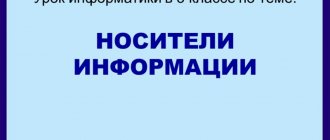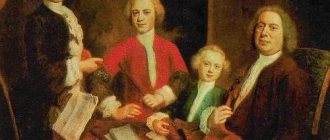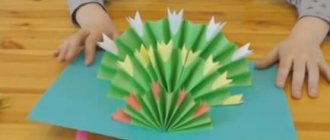Portrait in music 3rd grade music lesson plan
“There is a person hidden in every intonation.”
The purpose of the lesson: to teach how to distinguish one composition from another, distinguish between characters in musical works, and understand their moods and feelings.
Lesson objectives:
1. Disclosure of the artistic and visual functions of intonation in music.
2. Development of the emotional sphere of students.
3. Education of musical taste.
Lesson duration: 45 minutes
Lesson equipment:
- Audio – DVD – equipment
- Piano
During the classes.
- Organizational moment and setting the goal of the lesson.
(To encourage children to creatively comprehend musical material.)
-Hello, today we will learn how intonation can tell us about the character and mood of people. First, let's remember what intonation is?
Suggested answer: 1. Manner of pronunciation, reflecting some of the speaker’s feelings, tone.
2.The accuracy of the sound of a musical instrument when playing or voice when singing
- What are the intonations?
Suggested answer: Major and minor. Major can be bright, joyful, cheerful, open. And the minor one is sad, sad.
- Well done! Now try saying one phrase with different intonations? Ask your neighbor to sing a song!
(The teacher offers the children various intonations. For example: menacing, shy, joyful, lazy.)
-Very good! So, today we will find out - can we understand without words what the composer wanted to tell us in his work, what mood and what character?
- Main part.
— Now we will listen to a fragment from a piece of music. And I will deliberately not tell you the name. And then you tell us - what did you imagine with this music and what is its mood?
(While the teacher is playing the audio recording, he asks the children to remember how to listen to music correctly).
Suggested answer: Quiet, don’t talk, thoughtfully.
-Well done! Now let's listen to music!..
A fragment of Tchaikovsky P.I. sounds. "Doll Disease"
- So, what did the composer want to tell us with this music?
Expected answers from children: The mood of the music is sad, which means something sad happened.
It seems that the weather outside is bad, and this makes me sad.
— In fact, this is a work by P.I. Tchaikovsky “The Doll’s Disease.” (The teacher shows an illustration on the screen - an upset girl holding a doll in her hands). Well done, even though you presented different situations, you guessed the mood of the music correctly.
-Now listen to the next fragment and try to imagine some kind of image.
A fragment of M.P. Mussorgsky plays. "Baba Yaga".
— What is the character of this work, what character did you present?
Expected answers from children: Baba Yaga flies on her mortar over the forest.
Kashchei the Immortal menacingly flies around his forest.
Baba Yaga in a hut on chicken legs.
(The teacher shows on the screen an illustration of a cartoon Baba Yaga in a mortar).
- Well done. This is a work by Mussorgsky M.P. "Baba Yaga" from the series "Pictures at an Exhibition". Indeed, in this play the composer paints this scene very naturally: throws, pushes, blows are heard, Baba Yaga accelerates and flies.
-But now we’ll listen to how a character can be drawn in a song. (The teacher shows an illustration on the screen - a girl in a school uniform is counting something, bending her fingers).
— The famous children's poetess Agnia Barto has a poem “Chatterbox.” (The teacher reads a fragment of this poem).
Chatterbox (A. Barto)
That chatterbox Lida, they say, Vovka made it up. When should I chat? I have no time to chat!
Drama club, photo club, Choir club - I want to sing, Everyone voted for the drawing club too.
And Marya Markovna said, when I was walking out of the hall yesterday: “Drama club, photo club. This is too much of something.
Choose for yourself, my friend, just one circle.”
Well, I chose based on the photo... But I also want to sing, And everyone voted for the drawing club too.
And that chatterbox Lida, they say, Vovka made it up. When should I chat? I have no time to chat!
— Tell me, please, what are these poems about?
Suggested answer: The girl really wants to participate in all the clubs, but she doesn’t know which one is best to choose. It turns out that everything she does is only in words, so her classmate “Vovka” nicknamed her a chatterbox.
-Now let’s listen to what kind of music he came up with for these poems. S.S. Prokofiev. And can you tell me how the meaning of the poem is conveyed in music?
A fragment of Prokofiev S.S. is played. "Chatterbox."
-Here, we listened to a small fragment from this song. So how does music convey the meaning of Agnia Barto’s poem?
Suggested answer: When Lida lists the circles she would like to go to, the music is very lively and fast, but when she sings that Vovka calls her a chatterbox, she is offended and the music becomes slower and a little sad!
Today we are talking about intonation for the whole lesson, that it conveys both the character and the mood of the music, but, as we already recalled at the beginning of the lesson, intonation is also about hitting the notes exactly, and in order for us to sing a song well, it is imperative need to sing.
- Chant. -Let's play with intonation. Close your lips and try to repeat after me. (The teacher reproduces various intonations for the sound “mm.” And the children repeat after the teacher.
- Now let’s try the familiar chant “mi-ya, mi-ya, mi-ya-a-a-a” with a joyful intonation, then with a sad intonation.) Major – minor. (Children sing accompanied by piano).
-Chant for diction. “Brie-bre-bra-bro-bru”, changing the first letter to “g” and “p”. (Chorus for the development of active diction and articulation).
-Don't be lazy!
-Now let's remember the song that we studied in previous lessons.
Performance of the song “Hottabych” music: Gladkov G., lyrics: Entin Yu.
-Do you think that intonation in this song helps us draw the image of the main character?
Suggested answer: Yes!
-And in what way?
Supposed answer: cheerful, perky music, and in the chorus the word “Hottabych” is sung in an unusual way.
Work on breathing, accuracy of intonation, phrasing.
- Generalization.
-What new did you learn in class today?
Expected answers from the children: We learned that with the help of intonation you can draw any picture.
Show the character of a person or a fairy-tale character.
— What role does intonation play in our lives?
Suggested answer: Large. With its help, we can show our mood and describe events.
-And so, intonation is very important. It helps us better understand: each other, musical works. With its help, we see what the composer puts into his music.
Conclusion
The goal of the lesson has been achieved, the tasks have been completed. Students expanded their knowledge, skills and abilities.
Music lesson in 3rd grade
Lesson topic: “Portraits in music.”
This lesson uses problem-based learning technology. Students develop thinking skills - the ability to listen, prove and generalize, and develop the ability to compare and contrast.
The lesson uses a partial search method, methods of modeling, plastic intonation, graphic illustration, and the effect of surprise.
Lesson objectives:
teaching:
- develop thinking skills - generalization, ability to listen and prove
- development of the ability to compare, contrast
- developing the skill of integrating various types of art
correctional:
- creating conditions for optimizing students' creative abilities
- development of improvisation in forms accessible to children
- create an atmosphere of creativity in which students realize themselves and create their own
educational:
- fostering emotional responsiveness to music
- raising a competent listener
Lesson type:
Learning new material
Methods:
- verbal-inductive (conversation, dialogue)
- visual - deductive (comparison)
- partially search (improvisation)
- modeling
- plastic intonation
- graphic illustration
Lesson equipment:
- portraits of composers
- “Children's Album” by P.I. Tchaikovsky
- audio recordings for music series
- POWER POINT presentation
- piano, sheet music, music center
- illustrations on the topic, drawings by students
I. _ Organizing time.
E. Tilicheeva “Music lesson”.
II . Announcing the topic and objectives of the lesson.
III . During the classes.
U:
Guys, today we continue to study the topic “Portrait in Music”.
We have already listened to a fragment from the opera, in which the music told us about fairy-tale characters. What is the name of this fragment and what opera is it from?
D:
"Three Miracles" from the opera "The Tale of Tsar Saltan".
U:
Who is the author of this fairy tale?
D:
The fairy tale was composed by Alexander Sergeevich Pushkin.
(A portrait of Pushkin is projected on the screen.)
U:
Right.
Who is the author of the opera? (Portraits of Russian composers are projected on the screen - P.I. Tchaikovsky, M.I. Glinka, N.A. Rimsky-Korsakov, if the guys give the correct answer, the portrait of Rimsky-Korsakov increases in size and remains alone on the screen).
D:
Music composed by N.A. Rimsky-Korsakov.
U:
Right. What is another name for Nikolai Andreevich?
D:
A composer-storyteller, because he composed many operas based on fairy tales.
U:
Fine.
What is “opera”? (The term “opera” appears on the screen, an explanation of the term).
D:
Opera is a musical performance in which all the characters sing.
(An explanation of the term appears on the screen.)
U:
Right. What three miracles does music describe? Remember how music paints fabulous miracles?
(Listen to the audio recording of the beginning of each piece).
U:
Whose topic was just heard?
D:
The theme of the squirrel was heard.
(An image of a squirrel appears on the screen.)
U:
Right. How did you guess? What voice does the squirrel sing in?
D:
The squirrel sings in a ringing, high voice. The music in the play is cheerful, lively, playful, and light.
U:
Maybe some of you have already heard the melody of this song before?
D:
I heard it, but this song is very short - “Whether in the garden or in the vegetable garden.”
U:
Right. Rimsky-Korsakov included the Russian folk song “In the garden, in the vegetable garden” in his opera.
U:
Fine. What kind of miracle is this? What kind of music is here? (Show heroic posture and stand).
D:
The theme of heroes was heard.
(An image of the heroes appears on the screen.)
U:
What kind of music is here? What does it sound like?
D:
It sounds loud, strong, courageous, proud, in a low register. It looks like a procession, a march.
U:
What kind of miracle is this?
D:
The theme “Swan Princesses” was played.
U:
What is the nature of the play “The Swan Princess”?
What does the music represent? (The image of the Swan Princess appears on the screen.)
U:
How will our hands move to this music?
(Plastic intonation: the hand in the air draws the figure of a swan).
D:
The character is melodious, smooth, gentle, affectionate, beautiful. The music resembles the splashing of waves.
U:
Well done!
And now you will hear a play, the music of which also portrays to us the appearance of a fairy-tale character. The play was composed by the great Russian composer P. I. Tchaikovsky. (A portrait of P.I. Tchaikovsky appears on the screen.)
Now let's listen to music. Close your eyes and imagine this heroine.
(The play “Baba Yaga” by P.I. Tchaikovsky is played).
U:
Do you think this character is positive or negative, good or evil?
D:
Angry, unkind.
U:
Who might own such music? Please remember the most popular fairy tale characters. Who can you name?
D:
Baba Yaga, Koschey, Pinocchio, Carlson...
U:
Which of the listed heroes would suit such music?
D:
Baba Yaga!
U:
Absolutely right. How did you see her? What is her character?
D:
Baba Yaga is evil, treacherous, cruel.
U:
How did you understand this? The music of this piece is similar to the music of the theme of the Squirrel or the Princess - Swans? Are the sounds long and smooth?
D:
The sounds are short, sharp, angry, sharp, cutting off.
U:
Did all the sounds sound exactly the same, or maybe the composer emphasizes some sounds?
D:
Highlights.
(The term "accent" appears on the screen.)
D:
Yes, of course we hear louder sounds.
Pyotr Ilyich uses a technique in the play - accenting sounds. Guys, an accent is an emphasis in music. (An explanation of the term appears on the screen, recording the term in a notebook).
U:
How does the composer use accents?
How can you graphically represent this music? (Work at the board - graphic illustration).
U:
What does Baba Yaga do: does she sit in her hut or maybe she flies on a broom or in a mortar?
(An image of Baba Yaga appears on the screen, sitting in a hut and flying in a mortar.)
U:
How did you understand that she was flying? What is the tempo of the music?
D:
The pace is fast, lively, and does not stop.
(An image of a flying Baba Yaga appears on the screen.)
U:
What instrument is the piece performed on?
D:
The piece is performed on the piano.
U:
Interesting music, isn't it? Everyone who listens to her likes her. And the poet Viktor Lunin composed poems especially for this play. Listen.
(Reading a poem: teacher and student).
U:
Do you think the poet’s poems help us better understand music?
D:
Yes.
U:
And I have this suggestion: let’s try to sing this poem to the melody of P.I.’s play. Tchaikovsky.
(The teacher performs a fragment of the song and learns several lines with the children).
U:
Let's sing more expressively!
We will show the character of the heroine with intonation in our voice! (Repeated performance in character).
U:
Fine!
Thank you! Now let's turn into ballet dancers for a moment. I think you remember very well what ballet is. But still, let's say the definition out loud. Who wants to remind? (The term “ballet” and its explanation appear on the screen.)
D:
Ballet is a musical performance in which all the characters dance.
U:
Right. The dancers convey the content of the ballet through facial expressions, plastic movements, movements of the arms, legs, and dance movements. What gestures and hand movements could we use to further reveal the image of Baba Yaga?
What should our hand movements be: smooth or sharp? And how will we hold our palm: round, clench it into a fist, or maybe it would be better to spread our fingers? How do you think? Let's try to simulate!
(Modeling and plastic intonation).
D:
Movements should be short, sharp, sharp. It’s better to spread your palm out, as Baba Yaga should scare everyone.
U:
Let's get our hands to work. Don't forget: your hands should be expressive! Please stand up.
(Plastic intonation).
U:
How hard you all tried! Well done! Now let's try to combine our singing with plastic intonation.
(Performance of a fragment of a play with plastic intonation).
U:
Thanks to all! Well done! You managed to understand and convey the character of Baba Yaga. Have a seat!
And I want to tell you that the play “Baba Yaga” is included in the “Children’s Album” by P.I. Tchaikovsky.
(The image of the “Children’s Album” appears on the screen).
Guys, what other plays, besides this one, are included in the collection? Which plays are we already familiar with?
D:
“Mom”, “Sweet Dream”, “Old Doll”, etc.
U:
Well done! Don't forget!
What do you guys think, can Baba Yaga be funny? It turns out that this happens too.
Maybe some of you have met the funny Baba Yaga in fairy tales or cartoons?
D:
In the cartoon "The Flying Ship".
U:
Yes, in the cartoon “The Flying Ship” there lives not just one, but a whole multi-story hut of such cheerful forest old ladies.
They are even called funny - Babki - Yozhki. And they sing funny ditties. The music of these ditties and the entire cartoon as a whole was composed by Maxim Dunaevsky. (A portrait is shown).
( A vocal ensemble dressed in Babok-Ezhek costumes runs into the classroom, they perform ditties and also quickly run away).
U:
Well, they came running, made some noise, sang ditties and ran on.
It turns out how different Baba Yaga can be: evil and cheerful, insidious and funny.
Today we heard wonderful music that composers composed thanks to the fabulous image of Baba Yaga (portraits of P.I. Tchaikovsky and M.I. Dunaevsky without surnames are projected on the screen).
How many of you can name their last names? (If the answer is correct, the names of the composers are displayed on the screen).
D:
P.I. Tchaikovsky and M. Dunaevsky.
U:
Right. Why do you think I put photographs of both composers on the same slide? What can unite them?
D:
I think because they both composed music about Baba Yaga.
U:
Absolutely right. But they revealed this fabulous image to us in different ways. Besides this, what else did you learn?
D:
We learned about stress in music.
U:
Yes, we learned what an accent is in music. Guys, who remembers?
D:
Accent is the emphasis in music.
U:
Right.
You remember everything correctly. Well done! You did a good job today! (Encouraging students, grading).
At home I will ask you to complete the following task - draw a picture for the play “Baba Yaga” by P.I. Tchaikovsky.
In conclusion, I would like to say that there are a lot of fairy tales, they have always walked and will walk around the world, and you will sing to us about it now.
(With a hand gesture, the teacher asks the students to stand up,
children sing the song “Fairy Tales Walk Around the World,” during which an image of fairy-tale characters appears on the screen).
Thanks everyone for the lesson! Goodbye!



